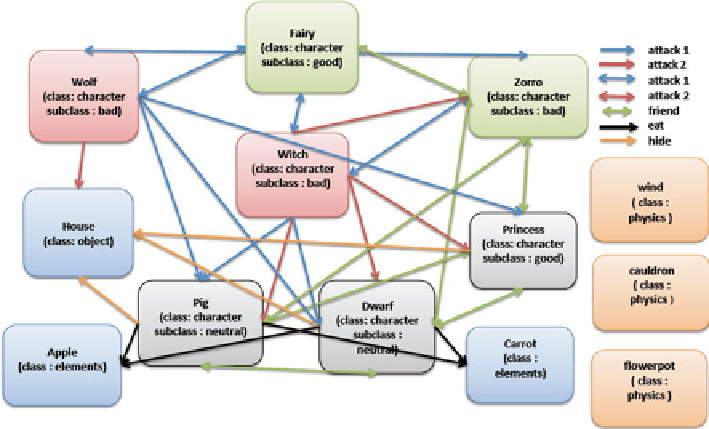Information Technology Reference
In-Depth Information
traditional story plots. As before mentioned, there are four types of entities: sce-
narios, elements, objects and characters. Scenarios represent the background image
where the action occurs. The elements (day, night and wind) interact with the objects
and the characters, bringing a dimension of change and unpredictability to the story.
The objects and characters are classifi ed in good, bad or neutral; bad characters
attack the good ones; good characters defend the neutral and help each other. Both
good and bad characters can join forces to defend or attack their opponents. Specifi c
objects like a caldron or a fl owerpot can be used to knock down bad characters and
defend the good ones. A bad object - like a poisoned apple - diminishes the health
of a character; on the contrary, a good object - like a carrot - increases the health of
a character.
The nature elements allow the confi guration of the story settings, e.g. the use of
the moon turns the day into night, or the cloud blows everything away from the
scene. Additionally, there are ambient sounds according to the different scenarios,
e.g. birds singing in the forest at dawn, frogs croaking or an owl singing at dusk.
Each entity has a BT, which defi nes a number of actions for that entity. In case
some specifi c rules or actions are needed, they can be added to the entities' BT. In
case it becomes necessary to add a new object or character to the story engine, it
only has to be associated with the corresponding BT and include the corresponding
animations, as well as the picture block. The new entity will automatically interact
with the other entities. The BT's interaction model rules each class and subclass;
basic indicators of the class are, e.g. health, velocity or symbiosis (entities that
belong to the same class join forces to achieve a common goal) (Chart 1).
Chart 1
Relations between the entities

